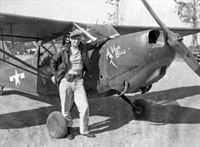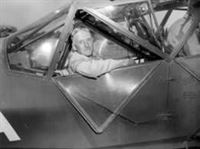Фотографии
-
Регистрационный номер: FL726 The Curtiss Kittyhawks of No 239 Wing were of critical importance in the Sangro battle. The aircraft were further adapted to carry three 500lb bombs. This Kittyhawk III, FL726, was operated by No 450 Sqn RAAF.
Самолёты на фотографии: Curtiss P-40D Kittyhawk / Warhawk - США - 1941
-
Each armed with a single 250lb bomb, a flight of Spitfire Mk VCs of of No 2 Sqn SAAF, part of No 7 Wing SAAF, heads out for another close-support mission in Italy. Although fast and agile, the Spitfire was less than ideal as a dive-bomber.
Самолёты на фотографии: Supermarine Spitfire Mk.V - Великобритания - 1941
-
Регистрационный номер: JF447 Spitfire HF. VIII JF447, coded UF-7, was the personal mount of Sqn Ldr Stanislaw Skalski, CO of No 601 Sqn, part of the RAF’s No 244 Wing, and is seen here at Gerbini, Sicily, on October 3, 1943. The squadron moved to Tortorella in south-western Italy two days later and on to Foggia-Triolo on October 18. Note the extended wingtips of the HF.VIII for high-altitude operations; standard Spitfire wingtips or clipped wings for low-level operations could be fitted.
Самолёты на фотографии: Supermarine Spitfire Mk.VI / VII / VIII - Великобритания - 1942
-
Регистрационный номер: NJ908 The Austers of the four RAF squadrons in Italy played an important part in the Rover system. Flown by Army pilots from advanced landing grounds, they could call in fighter-bombers to attack targets out of sight of ground controllers via their Army links. Seen here is Auster III NJ908 of No 651 Sqn, attached to the Army’s V Corps.
Самолёты на фотографии: Taylorcraft Auster - Великобритания - 1939
-
The ubiquitous Stinson L-5 Sentinel entered USAAF service in December 1942, initially as the O-62. The installation of VHF radio equipment in the Horsefly Sentinels enabled their pilots to talk directly to circling fighter-bombers, whereas the RAF’s Auster pilots had to pass all instructions through the ground-based Rover system.
Самолёты на фотографии: Stinson L-5 Sentinel - США - 1942
-
A USAAF pilot of the 47th Liaison Sqn poses beside his Sentinel, Vegas Belle. Although the Horsefly system’s direct contact between air observation post and fighter-bombers appeared to offer an advantage, there was a grave risk of Allied ground troops being on the receiving end of friendly fire owing to a lack of tactical oversight of the battlefield as a whole.
Самолёты на фотографии: Stinson L-5 Sentinel - США - 1942
-
The American Secretary of War Henry L. Stimson in the back of an L-5 Sentinel before an observation flight over US Fifth Army positions in the Cecina area of Tuscany in the summer of 1944.
Самолёты на фотографии: Stinson L-5 Sentinel - США - 1942
Статьи
- -
- A.Arthy - Dieppe. The Luftwaffe Perspective
- A.Grandolini - On the wings of the Hansa (3)
- G.Smith - Pan Am's "Rogue" Atlantic Clippers
- K.Hayward - The Stop & Go Show
- K.Lande - Flash!
- L.Andersson - Turkish dismay
- L.Hellstrom - Sabena's Congo Ventilators
- M.Bearman - The other sound barrier
- N.Stroud - How quiet is our STOL?
- P.Davidson - Off the Beaten Track...
- P.Jarrett - Lost & Found
- R.Lezon, S.Rivas - The patagonian eagle
- T.Singfield - "A very nasty situation..."
- V.Flintham - Rover David (2)






